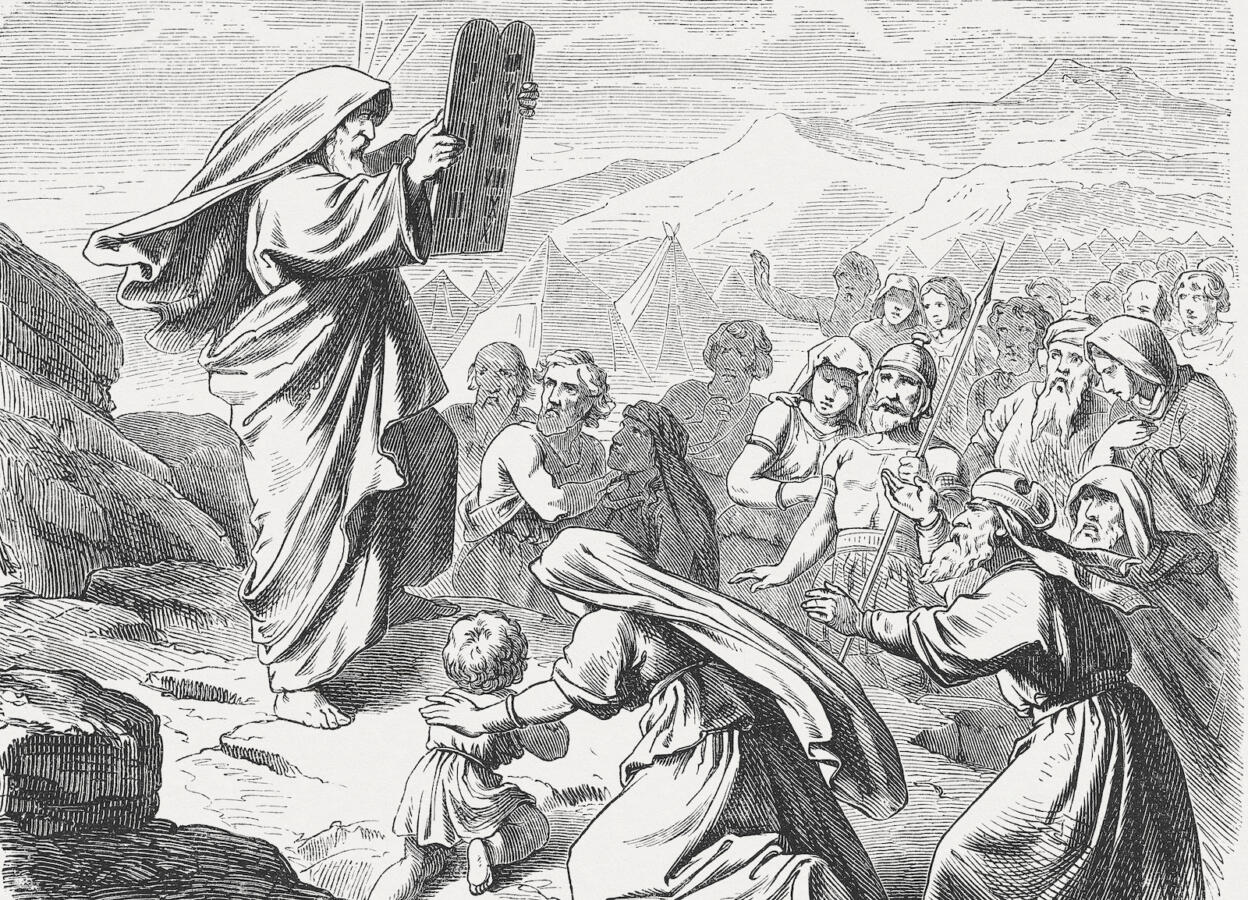On the third day of the third month after the ancient Israelites left Egypt, God descended in a cloud upon Mount Sinai in view of the entire nation. According to the account in chapter 19 of Exodus, God then began speaking to the people, delivering first the Ten Commandments followed by a lengthy compendium of civil and religious laws. According to the Jewish understanding, this marked the beginning of God’s giving of the Torah to the Jewish people.
The revelation at Sinai is among the most significant events in the Jewish tradition — and, in fact, can be said to have been the start of Jewish (as opposed to Israelite or Hebrew) tradition. Most plainly, it was the moment when God’s will, distilled through the Torah’s myriad laws, was expressly communicated to human beings. For the ancient Israelites, Sinai was the moment when a people forged through the shared experience of Egyptian bondage became united by a common religion. Sinai also represents something remarkable not only in Jewish history, but in the entire history of religion — a deity entering a covenant with a group of human beings in which both parties are bound by mutual commitment.
What Actually Happened at Sinai?
The principal record of the encounter between God and the Israelites at Sinai is contained in the Book of Exodus, beginning in chapter 19. The telling continues for many chapters thereafter, during which Moses ascends the mountain multiple times. Some aspects of this encounter are retold in the Book of Deuteronomy.
As chapter 19 of Exodus begins, we find that the Israelites, recently freed from slavery in Egypt, are encamped at the foot of Mount Sinai. God then tells Moses to convey the terms of the covenant into which the Israelites are invited: If the people keep God’s commandments, God will make them a treasured people and a holy nation. Moses relays these terms to the elders, who accept them, vowing to do whatever God commands. Moses then tells the people to prepare themselves for three days by abstaining from sex, maintaining a state of purity and washing their clothes.
With your help, My Jewish Learning can provide endless opportunities for learning, connection and discovery.
At dawn of the third day, God descends on the mountain in a dense cloud amid thunder and lightning and the sounding of the shofar. The text describes the scene this way: “Now Mount Sinai was all in smoke, for God had come down upon it in fire; the smoke rose like the smoke of a kiln, and the whole mountain trembled violently. The blare of the horn grew louder and louder. As Moses spoke, God answered him in thunder.” (Exodus 19:18-19)
God then speaks the Ten Commandments aloud. This frightens the people, who are afraid that hearing God’s voice will lead to death. They beg Moses to speak to them instead, and promise they will obey his commands. Moses reassures them there is no need to be afraid. The people then remain at a distance while Moses returns into the cloud.
Over the next several chapters, the text records a large body of criminal, civil and religious laws that were promulgated at Sinai. When that is complete, God again beckons Moses to come near. Moses repeats all the laws to the people, who agree to follow them, then writes the laws down, constructs an altar and performs sacrifices to God, and reads the laws out loud again.
After all this, Moses is summoned to ascend the mountain again to receive the tablets upon which God has inscribed the laws. For 40 days, Moses communes with God on the mountaintop, receiving a detailed body of laws concerning the construction of the Tabernacle and the sanctification of the priests and their clothing. Meanwhile, the Israelites are getting restless out of despair that Moses may not return. So they pool their gold to construct a calf to replace the God they feared had abandoned them. This enrages God, who threatens to annihilate them. But Moses successfully intervenes, reminding God of the promise to make the Israelites as numerous as the stars. But when Moses descends the mountain and sees for himself what the people have done, he is enraged and hurls the tablets to the ground, shattering them. After destroying the idol, he ascends the mountain again for a second set of tablets. This time, when he returns to the people his face is radiant and the people are afraid to approach him. But Moses reassures them and relays to them all that God had told him.
The Significance of Revelation
The revelation at Sinai marks the beginning of Judaism as a revealed tradition oriented around a sacred scripture. Though Jewish tradition holds that the patriarch Abraham and his family — the first Hebrews — observed Torah laws, revelation is the first time those laws were enumerated and written down.
Moreover, revelation is the source of the Jewish claim that its traditions are divinely ordained. Later Jewish traditions state explicitly that not only did Moses and the Israelites receive the written word of God, but even the Oral Torah — the vast collection of commentaries, explanations and extrapolations of those laws recorded in the Mishnah, the Talmud and the later legal codes — was revealed at Sinai as well. The claim that the Torah is a faithful transmission of what was given to Moses at Sinai is made in the Mishnah (Avot 1:1) and is the eighth of Maimonides’ 13 Principles of Faith.
The revelation was also the first — and arguably, the only — time in which a people entered into a deal with God. The terms of that covenant are spelled out in Exodus 19:4–5. God promises that if the people obey the commandments, they will become God’s treasured people, a kingdom of priests and a holy nation. As Rabbi Jonathan Sacks has observed, the covenant “set moral limits to the exercise of power … [and] established for the first time the primacy of right over might.”
Commemorating Revelation in Jewish Tradition
Seven weeks after Passover, which celebrates the Exodus from Egypt, Jews commemorate the giving of the Torah on Mount Sinai during the holiday of Shavuot, when it’s traditional to stay up all night studying Torah. Jews also read the Book of Ruth on Shavuot, in part because Ruth’s commitment to her mother-in-law Naomi and her decision to join the Jewish people resonates with Israel’s entrance into the covenant at Sinai. In Sephardic communities, it is customary to read a special ketubah l’shavuot, a symbolic marriage contract between God and the Jewish people — a practice that, following imagery found in the prophets and elsewhere, imagines the revelation at Sinai as a joyful wedding between God and God’s chosen people.
Revelation at Sinai is also given a prominent place in the daily Jewish liturgy. The three blessings that surround the Shema are built on the themes of creation, revelation and redemption. These blessings reflect the Jewish view that history is played out in three acts, beginning with the creation of the world, shifting decisively with the revelation at Sinai, and one day drawing to its successful conclusion with the coming of the messiah.



